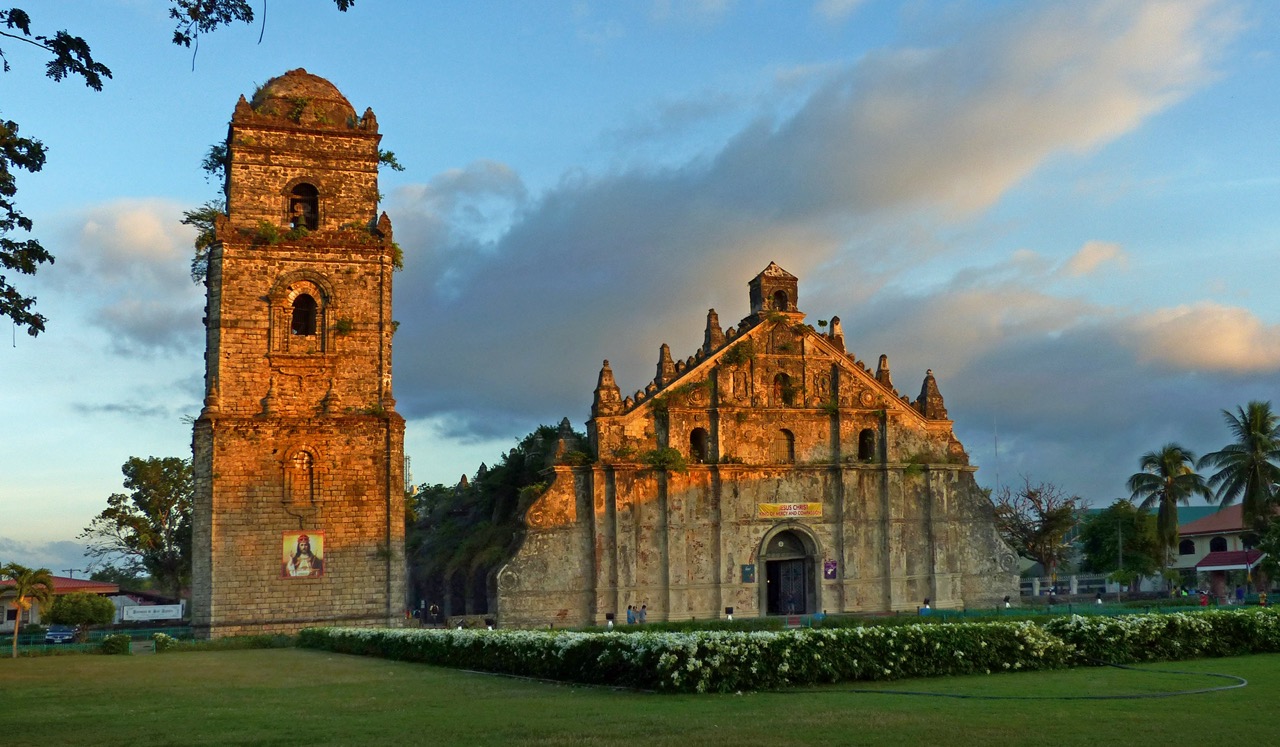
7 Famous Churches in the Philippines
The Philippines is a well-known bastion of Catholic Christianity in Asia. Countless places of worship dot the country’s landscape, serving as enduring symbols of the nation’s centuries-long religious heritage. Each of these famous churches in the Philippines tells a unique story, reflecting the diverse ways in which Filipinos embrace and practice their faith.
Manila Cathedral (Intramuros, Manila)
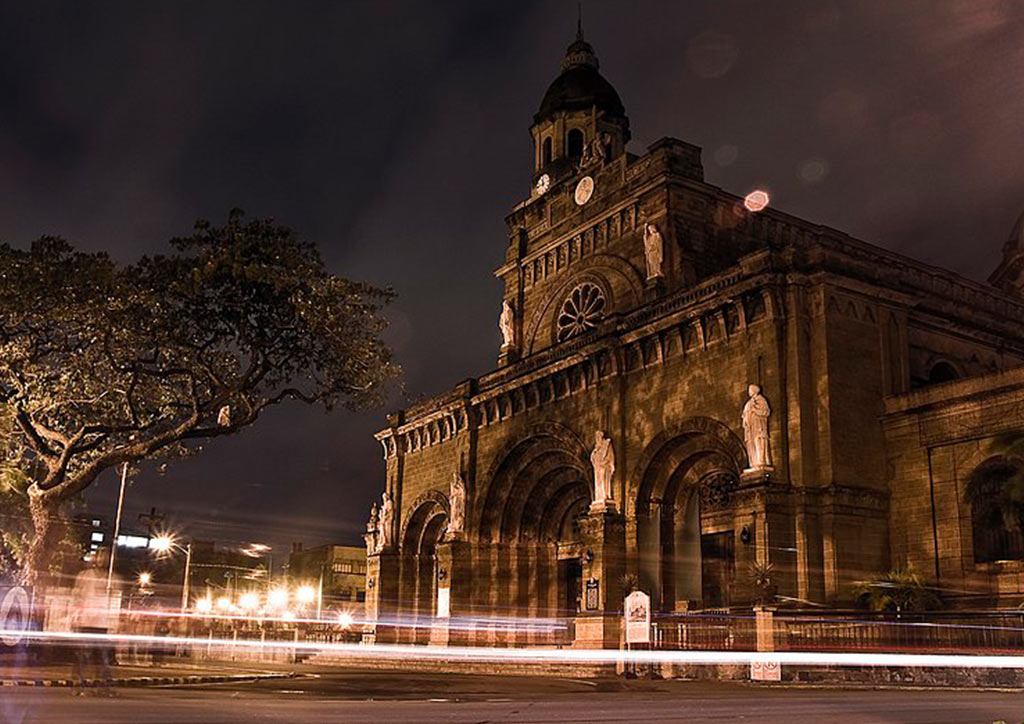
Considered the main Roman Catholic Church in the country, The Manila Cathedral stands tall as the epicenter of the country’s Christian origins. The surrounding historical air of Intramuros accentuates its role as a key structure in Filipino history and culture. Miguel Lopez de Legazpi, the conquistador who expanded the Spanish empire into the East Indies, chose the location of the cathedral. And in 1571, over 450 years ago, secular priest Frey Juan de Vivero established the church.
The structure itself underwent many changes throughout the years. Numerous natural disasters and a world war resulted in repeated rebuilding efforts throughout the centuries. From its humble beginnings as a bamboo and nipa structure, the church since evolved into today’s neo-Romanesque ecclesiastical structure.
Manila Cathedral’s first permanent structure was destroyed in a fire in 1583. A new stone cathedral was constructed in 1592. Despite this precaution, the cathedral still suffered damage from earthquakes over the years.
The cathedral underwent further reconstructions and enhancements in the 17th and 18th centuries. Each iteration of the building was designed to be stronger and more magnificent than the last. When a powerful earthquake severely damaged the cathedral in 1852, yet another a significant reconstruction effort worked to restore the cathedral to its former glory.
However, the most devastating blow came in 1945 during the Battle of Manila in World War II. The cathedral was almost completely destroyed, with only its walls left standing amidst the ruins. In 2012, the retrofitting and renovations conducted secured the church’s longevity and structural integrity.
Throughout its history, the Manila Cathedral has risen from the ashes multiple times, embodying the perseverance of the Filipino people. Today, it remains a symbol of the country’s rich cultural and religious heritage, attracting visitors from around the world.
Jaro Cathedral (Jaro, Iloilo City)
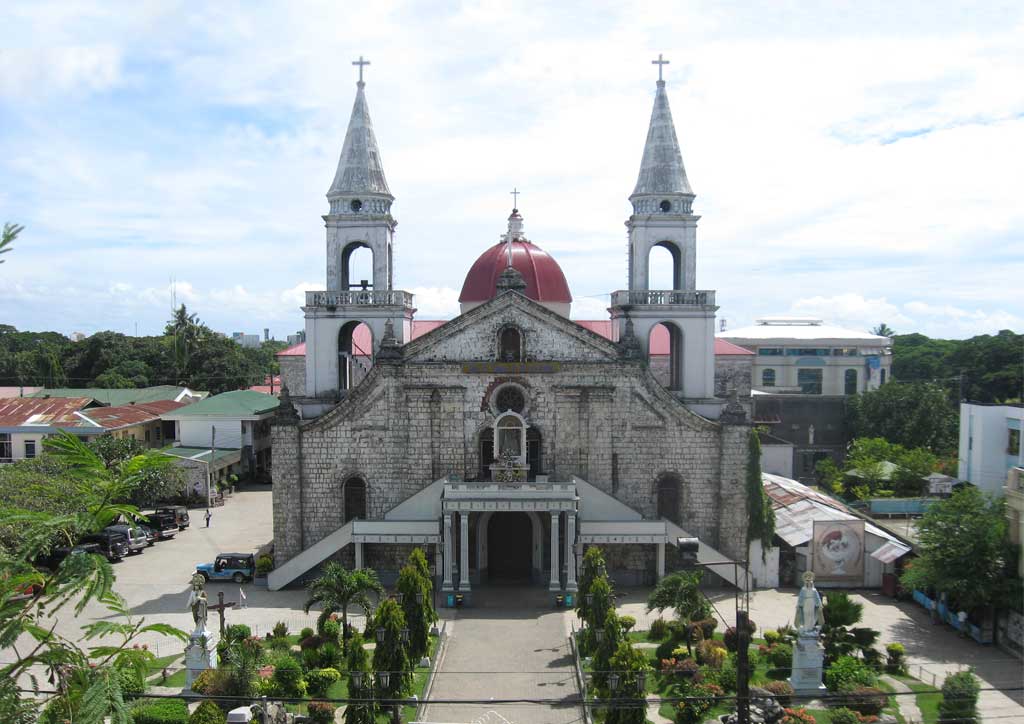
Dedicated to St. Elizabeth of Hungary, Jaro Cathedral in Iloilo City showcases Baroque architecture, constructed primarily from coral stones and bricks. Established in 1575, the cathedral originally served as a chapel-of-ease for the people of Oton. Threats of invasion and natural disasters led to its transfer to its current location, Jaro, in 1636.
Architecturally, the cathedral subscribes to a romanesque revival style. The use of arches and thick masonry characterizes the aesthetic of the building. Unique for its separate belfry across the street, originally a lookout for pirates, Jaro Cathedral underwent several renovations, especially after the 1948 Lady Caycay earthquake caused significant damage. It houses the revered Nuestra Señora de la Candelaria (Our Lady of the Candles), the only Marian image in the Philippines crowned by Pope John Paul II in 1981, elevating the cathedral to the National Shrine of Our Lady of the Candles.
Today, Jaro Cathedral remains a vibrant center of Catholic faith, attracting pilgrims and visitors as one of the most famous churches in the Philippines. It celebrates the Feast of Our Lady of the Candles every February 2nd, drawing devotees nationwide, embodying the Filipino people’s enduring faith and resilience.
Paoay Church (Ilocos Norte)

Also known as the Saint Augustine Church, Paoay Church was built in 1694 by the Augustinian friar Father Antonio Estavillo. Recognized as a UNESCO World Heritage Site, it is a National Cultural Treasure. Earthquakes damaged the church in the latter half of the 1800s. Recently, the National Historical Commission of the Philippines restored the Paoay Church in June 2020. These renovations addressed concerns of the structural integrity in consideration of the history and age of the structure.
The church is aesthetically classified as Spanish-era earthquake Baroque architecture. Developed in colonial Spanish America and the Philippines, it’s a style characterized by its thick, heavy walls, lower and narrower structures, robust buttresses, and stronger foundations, tailored to withstand the forces of earthquakes. Decorative elements are often simpler than traditional Baroque to minimize the risk of injury from falling debris. Additionally, bell towers are usually built lower and separate from the main structure to prevent collapse onto it during an earthquake.
Paoay Church’s 24 large buttresses, structures built against or attached its walls to support it, differentiates it from the usual baroque designs of the time. The facade of the structure showcases both Gothic and Chinese elements and is reminiscent of Javanese architecture. Large coral stones and bricks ornament the walls while being held together by a distinct mortar mix that uses sugarcane juice boiled with mango leaves.
Miagao Church (Miagao, IloIlo)
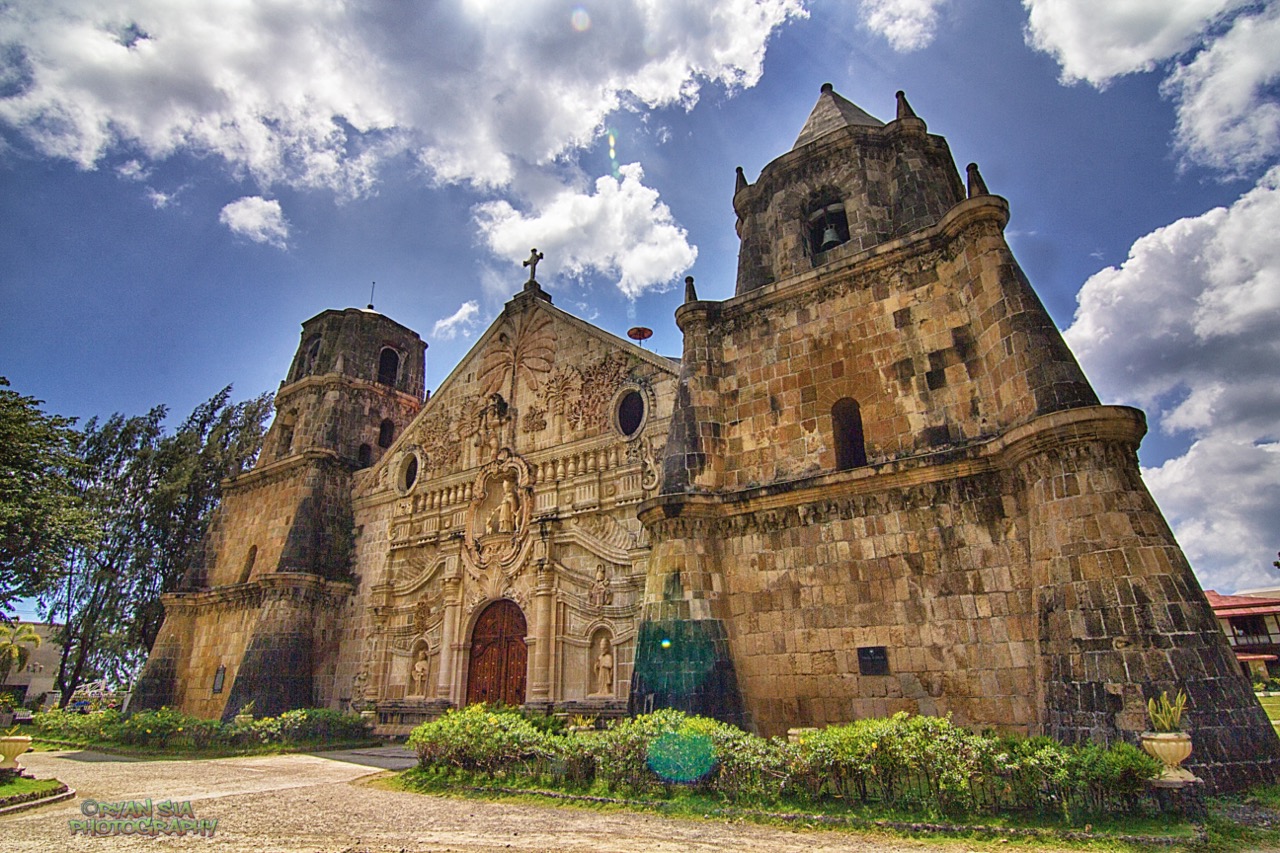
The Santo Tomás de Villanueva Parish is a historical church located in Miagao, IloIlo. It was declared a UNESCO World Heritage Site, alongside other famous churches in the Philippines, on December 11, 1993.
Moro invaders frequently attacked the original town from 1741 to 1754. This led to the town and church’s relocation, with construction completed in 1797. The town’s people built the church on the highest point and reinforced it further against any attacks or natural disasters. The present church is the third iteration of the structure.
The Miagao Church is stylized in the fashion of Baroque-Romanesque and is primarily made of adobe, egg, coral, and limestone. The exaggerated wall thickness of 1.5 meters is further reinforced by buttresses that measure 4 meters thick. Its two belfries frame the facade on each end, with its center intricately decorated with a bas relief. The design of the relief contains multi-cultural influences and a depiction of the coconut tree. The massive belfries also act as watchtowers in the case of invasion.
Basilica Minore Del Santo Niño (Cebu City)
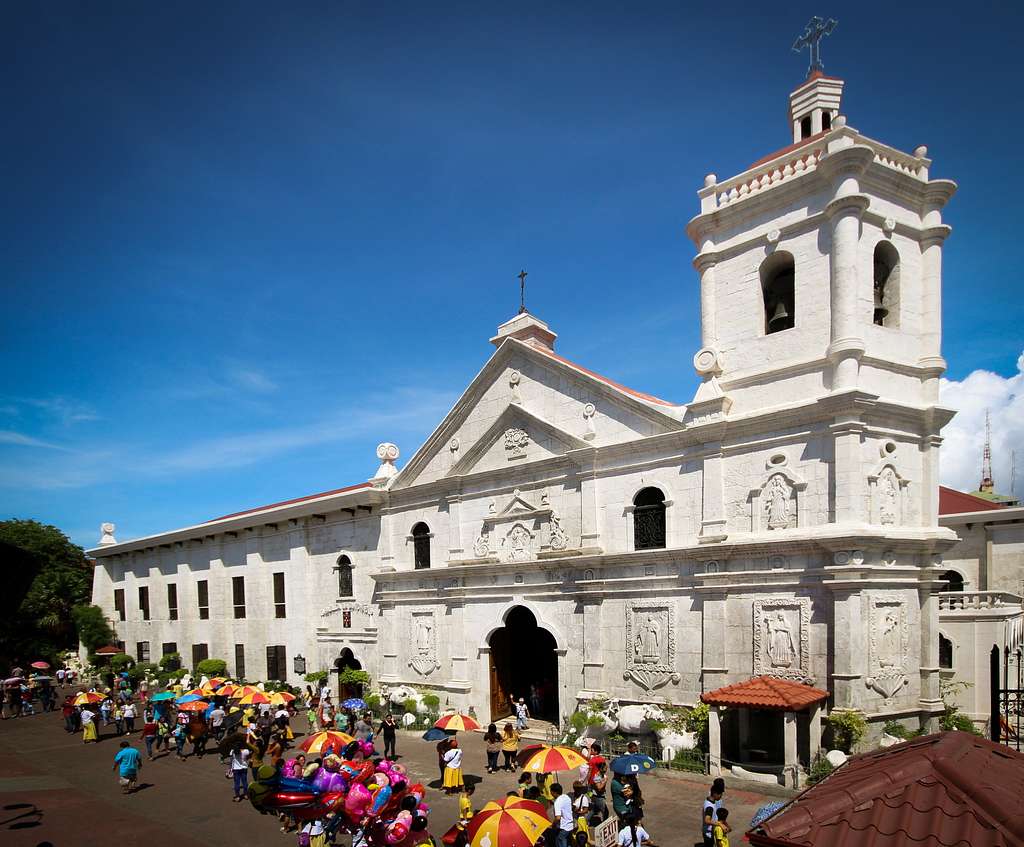
The Minor Basilica of the Holy Child, commonly known as the Santo Niño Basilica, is the oldest Catholic church in the Philippines. The tale of its founding is based on the encounter of the image of Santo Niño de Cebú and Miguel Lopez de Legazpi. Before that, Ferdinand Magellan presented this image to Raja Humabon during the latter’s baptism. The church is designated as a national landmark and is hailed as the birthplace of christianity in the country.
The original church was built on November 1, 1566 from wood and nipa. The current church, completed in 1740, began construction in 1735. Throughout the five-year building period, the friars encountered significant logistical challenges, including limited access to materials and a shortage of skilled labor in the area. In 2013, an earthquake severely damaged the church’s belfry, facade, walls, and frescoes. Fortunately, the National Historical Commission of the Philippines carefully repaired the structure and restored it into its new and reinforced form.
Like the other famous churches in the Philippines built during its time, the style of this church falls under earthquake Baroque. Its asymmetrical facade has the church’s bell tower located on its right. Its cruciform floor plan design services masses while also houses amenities such as the Basilica del Santo Niño Library and Museum. The pilgrim center, opposite to the basilica, accommodates the growing number of devotees.
Daraga Church (Daraga, Albay)
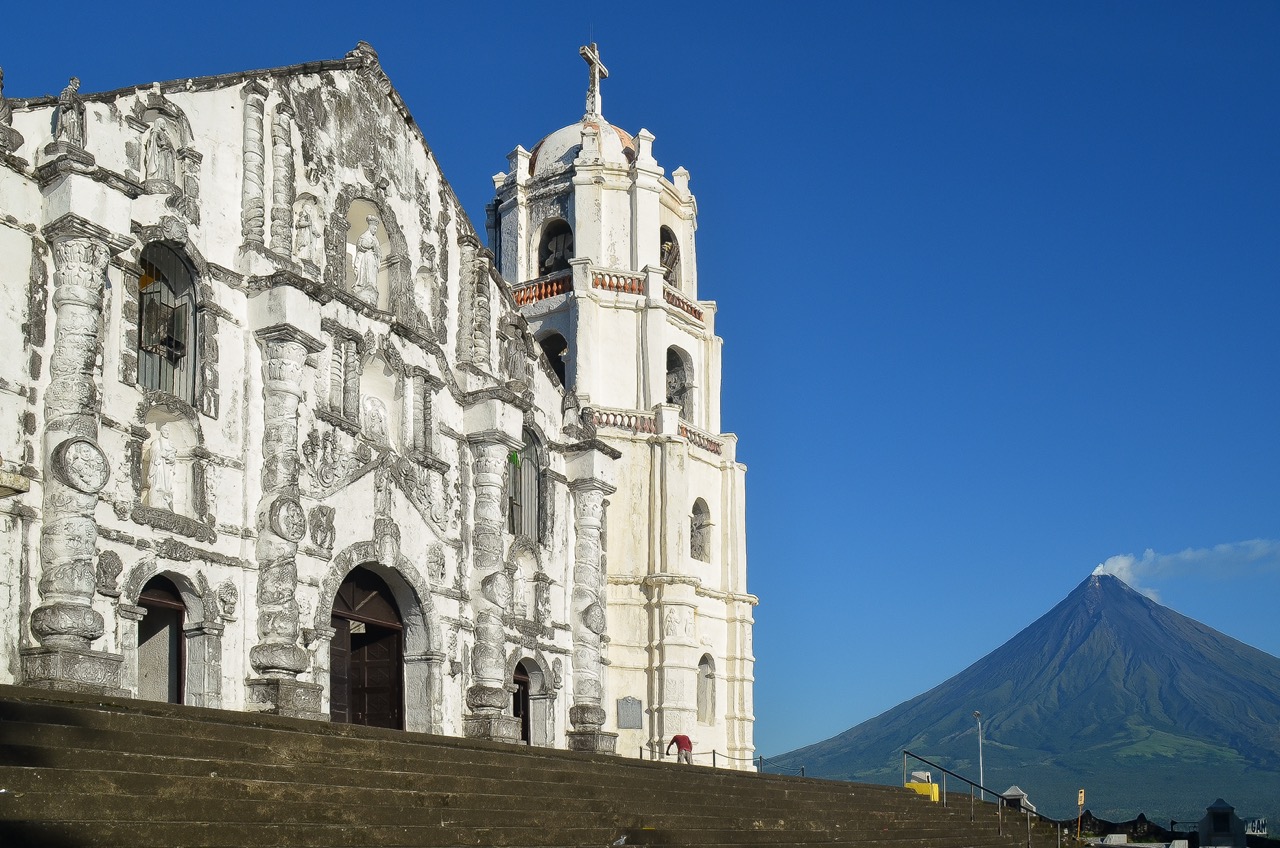
Franciscan Friars built the Nuestra Señora de la Porteria Parish Church in 1773. In 2007, the National Museum of the Philippines designated specific sections of the church as a National Cultural Treasure. The church overlooks the Mayon Volcano as it sits on a hill in Barangay Santa Maria.
Unfortunately, military bombers damaged the structure during World War II, resulting in its ruin. A hasty restoration, done with different styles, made it incompatible with the church’s mandate. In 1973, the Vatican II Council required the church to conform the conventions it set.
The church exudes the aesthetic of ultra baroque, or Churrigueresque, especially in its facade. Considering its proximity to the Mayon Volcano, volcanic rocks form both the facade and its walls. The salomónicas, or the spiral Solomonic columns, each bear depictions of the four Evangelists of Christianity. In contrast to the typical styles of churches in the Philippines, there are no vertical columns nor horizontal cornices on its facade.
Molo Church (IloIlo City)

The Saint Anne Parish Church primarily depicts images of female saints, earning it the title as “the feminist church”. Fray Pablo Montaño initiated its construction in 1831. The structure has seen its fair share of Filipino history. National Hero of the Philippines Dr. Jose Rizal visited the church in 1886 to view its biblical paintings. During World War II, civilians found refuge in its halls as an evacuation center civilians. The country’s struggle for liberation, from the Japanese, caused damage to church. In the aftermath, Fr. Manuel Alba oversaw the repair of the church with the help of the locals.
The church facade emphasizes styles of Gothic-Renaissance Revivalism, as seen in the towers adorned with numerous spires and pointed arches. Inside the church grounds, the faithful will find three naves that contain statues of 16 of female saints. Lastly, the church contains a total of five altars, with the high altar housing the image of Saint Anne on its reredos.
These famous churches in the Philippines stand as majestic testaments to the country’s deep-rooted Catholic faith and rich colonial history. Each church, with its unique architectural style, from Earthquake Baroque to Neo-Gothic, offers a glimpse into the Philippines’ artistic and cultural heritage. These historic churches, many of which have survived natural disasters and wars, continue to serve as vital centers of worship and community gathering. They attract pilgrims and tourists alike, showcasing the enduring spirit and faith that define the Filipino identity. These renowned edifices are crucial in preserving and narrating the Philippines’ storied past to future generations.


